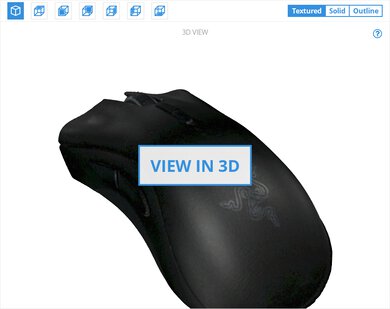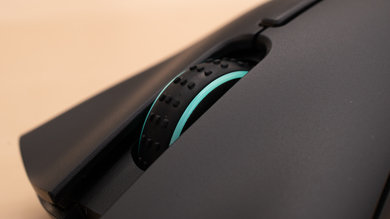Our Verdict
Good to use as an office mouse. It has a nice ergonomic shape for right-handed people and offers a few customizable buttons. It might not be ideal for smaller hands if you use claw or fingertip grip, but it'll be fine for palm grip. This mouse is also wired-only, so you'll have to route its cable so it doesn't bother you on your desk.
- Very good for gaming.
- Excellent performance.
- Very well-built design.
- Almost universal for all hand sizes and grips.
- Not recommended for smaller hands, unless using palm grip.
- Rigid cable.
- Not suitable for traveling due to wired-only use and size.
Very good for video games like FPS. It has amazing performance and can be customized to suit your preferences, but it isn't the lightest option. On the upside, its click latency is decently low and the mouse feels responsive. It also has a few programmable buttons, which is good. It's also suitable for most hand sizes, although people with small hands might feel like their hand posture is awkward when using the claw or fingertip grip.
- Very good for gaming.
- Excellent performance.
- Very well-built design.
- Almost universal for all hand sizes and grips.
- Not recommended for smaller hands, unless using palm grip.
- Rigid cable.
- Not suitable for traveling due to wired-only use and size.
Very good for MMO games. It has a few programmable buttons, but not as many as MMO mice with a side panel filled with extra buttons. It might also be too big for small hands if you're using the claw or fingertip grip, but otherwise, this mouse is pretty universal for most right-handed people. Its wired design allows very low latency, which is good for gaming.
- Very good for gaming.
- Excellent performance.
- Very well-built design.
- Almost universal for all hand sizes and grips.
- Not recommended for smaller hands, unless using palm grip.
- Rigid cable.
- Not suitable for traveling due to wired-only use and size.
Decent for ultra-light gaming. This mouse's performance is excellent, but it's just under 100g if you elevate the cable with a bungee. This is noticeably higher than ultra-lightweight gaming mice, but isn't too heavy. The wired latency is low and the mouse is suitable for almost any hand size and grip, other than smaller hands with a claw or fingertip grip.
- Very good for gaming.
- Excellent performance.
- Very well-built design.
- Almost universal for all hand sizes and grips.
- Not recommended for smaller hands, unless using palm grip.
- Rigid cable.
- Not suitable for traveling due to wired-only use and size.
Not recommended for traveling. It's quite bulky and wired-only. This won't be great for using on the train or a plane with a laptop.
- Very good for gaming.
- Excellent performance.
- Very well-built design.
- Almost universal for all hand sizes and grips.
- Not recommended for smaller hands, unless using palm grip.
- Rigid cable.
- Not suitable for traveling due to wired-only use and size.
Changelog
- Updated Sep 28, 2022: We've converted this review to Test Bench 1.2. This update simplifies our Weight test and expands on our CPI test from Test Bench 1.1, resulting in changes to test results in both sections. For more details, you can see our complete changelog here.
- Updated Sep 21, 2022: We've converted this review to Test Bench 1.1. This update revamps our Click Latency test and results in changes to test results. For more details, you can see our full changelog here.
- Updated Oct 05, 2020: Converted to Test Bench 1.0.
- Updated Dec 20, 2019: Converted to Test Bench 0.8.1.
Check Price
Popular Mouse Comparisons
The Razer DeathAdder Elite is a very good gaming mouse. It's a popular model that's also available for left-handed people, although it's the regular DeathAdder and not the Elite version. It has a very good build quality, amazing performance, and is amazing with a palm grip. Unfortunately, its cable is similar to most Razer mice, which is quite stiff and annoying. See our recommendations for the best wired mouse, the best gaming mouse, and the best mouse. If you're interested in Razer products, also check out the best Razer mice.
The Razer DeathAdder Elite and the Razer DeathAdder Essential have the same shape and size, but the Elite performs better overall. It has a much wider CPI range, and its CPI can be adjusted much more precisely in increments of one. Also, its minimum lift-off distance is lower, and it has two programmable buttons below its scroll wheel, which the Essential lacks.
The Logitech G502 HERO is a larger gaming mouse than the Razer DeathAdder Elite and will be tougher for people with small hands to grip comfortably. While both mice are wired-only, the Logitech has a higher-quality cable that is more flexible. The Logitech also has more programmable buttons, a much better scroll wheel with L/R tilt, and an unlock button for free scrolling.
The Razer Mamba Elite and Razer DeathAdder Elite are very similar wired gaming mice. They're both right-handed mice that are good for all hand sizes with palm grip and all hand sizes except small for both claw and fingertip grip. The DeathAdder Elite's CPI is adjustable by increments of 1, which is outstanding and helps you precisely fine-tune its performance for your preference. On the other hand, the Mamba Elite has two more programmable buttons, as well as on-board memory, so you can maintain your settings if you switch PCs.
The Razer DeathAdder V2 is a better mouse than the Razer DeathAdder Elite. It's lighter, has a much less stiff and rigid cable, a better sensor, and on-board memory, so you can save your customization settings to the mouse and keep them if you switch PCs. On the other hand, the DeathAdder Elite can often be found much cheaper.
Test Results

The Razer DeathAdder Elite looks like a gaming mouse, but without having a futuristic look. It's fairly simple and sleek, with the Razer logo on the back. Unlike the Razer DeathAdder Essential, which only has green lighting, the Elite has RGB lighting on both the logo and on each side of the mouse wheel. It has a slight downward slant on the right side, too. There are also some Overwatch, Destiny 2, and SKT T1 special editions.
The Razer DeathAdder Elite is a very well-built gaming mouse. It's made of solid plastic and there are no wobbling parts. The mouse feels a bit less loose than the Mamba Elite since the DeathAdder doesn't have the ability to tilt its mouse wheel, but this is a very minor difference. Its feet are fairly good and glide well.
There isn't any weight optimization with this mouse. It still feels decently light, but isn't as light as some ultra-lightweight gaming mice. If you want a lighter mouse, look into the Corsair HARPOON RGB.
This mouse's ergonomics are very good for right-handed people. There are latex grips on the side to help grab the mouse firmly and it's quite easy to reach all the buttons, too. It's a fairly long mouse, so it's more suitable for palm and claw grip, but you can also use the fingertip grip if you don't have smaller hands. For a true ambidextrous design with side buttons on both sides, check out the Corsair M55 RGB Pro or the SteelSeries Sensei 310. If you want a non-slanted design with a lower back hump, check out the Razer Viper. If you're interested in a mouse with similar performance but with an internal fan intended to keep your hand cool and dry, take a look at the Marsback Zephyr RGB.
Note: There isn't a left-handed version of this mouse, but there is one for the regular DeathAdder.
The Razer DeathAdder Elite is a wired-only mouse. If you want a wireless mouse that still performs great, check out the Razer Mamba Wireless.
The DeathAdder Elite has a typical braided Razer cable. Just like the Naga Trinity's, this mouse's cable is rigid and not very flexible. The cable maintains a lot of kinks, which can be bothersome when using the mouse. If you want something with a much better cable, check out the Razer DeathAdder V2, as it uses Razer's new cable which is much less rigid and stiff.
The Razer DeathAdder Elite doesn't have as many programmable buttons as MMO mice, but still has enough for most gamers. You can also reprogram pretty much any button, including scroll up and down. For a similar but wireless mouse that has CPI buttons on the edge of its left click, check out the Razer DeathAdder V2 X HyperSpeed.
The Razer DeathAdder Elite's wired click latency is good, and most people will be satisfied with it. You won't notice any delay when gaming with it. If you want a mouse with even lower click latency, check out the XTRFY M4 RGB.
The Razer Synapse 3 is fairly good software, but the options with the DeathAdder Elite are quite sub-par. The mouse doesn't have onboard memory, so you won't be able to use it with multiple computers, but this might not be an issue for most gamers that only have a single setup. Unfortunately, you can't save multiple profiles and switch between them. There are also a few more features if you do create an account, like saving your settings and lighting patterns for all Razer products.
Excellent compatibility. Although the Razer Synapse 3 software isn't available on macOS, you can still use the Razer DeathAdder Elite on both Windows and macOS. You won't be able to customize your settings on macOS, but other than that, all the default buttons and settings work with it. Check out the similar SteelSeries Rival 710 if you need full macOS compatibility.














